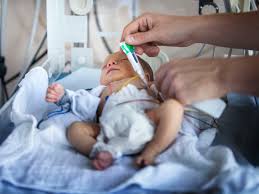Source: insider.com
American women are having fewer children than ever before, a trend some medical experts have attributed to delayed child rearing. Others disagree and say the drop is due to stifling socio-economic factors, including rising childcare costs and a lack of supportive government programs for working mothers.
The US’ total fertility rate, the number of children a woman is expected to have in her lifetime, hit a record low in 2018, according to a new report released on Friday by the Centers for Disease Control and Prevention (CDC).
That year, the average woman in the US was projected to have a total of 1.7 children in her lifetime. In order for the current generation to replace itself, women need to have at least two. Since 2008, fertility rates have dipped below that level, according to the CDC.
Fertility rates may be falling due to delayed childbirth and financial factors
Medical and economic experts are divided as to why fertility rates have been declining consistently.
Some experts in reproductive medicine say the drops are largely due to women waiting to get pregnant and being unable to have a baby once they decide they’re ready.
But some economic experts disagree, and say many women have no choice but to have fewer children than they thought they would, or no children, because of stifling financial factors, and the fact that there aren’t sufficient government programs to support mothers.
“Economic instability and unaffordable care could be factors for people deciding to have children later in life, or not at all,” Josie Kalipeni, policy director of Caring Across Generations, a healthcare advocacy campaign, told the Atlantic last year.
But even with major advances in assisted reproductive technology, some medical experts think that women can’t afford to wait much longer than past generations typically did to have children.
Dr. Eve Feinberg, associate professor of obstetrics and gynecology at Northwestern University, has joined that camp of experts.
She told Insider last year that part of the reason why fertility rates have declined is because there’s misinformation around the efficacy of assisted reproductive technology, and that women of advanced reproductive age often expect more from treatments, including in-vitro fertilization, than they can actually offer.
“People overestimate the success of fertility treatment,” Feinberg told Insider last year. “While it is successful, it has limitations at older ages.”
After 35, a woman’s chances of getting pregnant through IVF drops
Women younger than 35 have a 21.3% chance of getting pregnant using assisted reproductive technology, and having a full-term baby of normal weight, according to a 2015 CDC report. But those numbers steadily drop as women get older. After 35, a woman’s chances decline to 17% and after 38, it’s 11%.
Despite those figures, some population experts disagree with Feinberg and say that the falling fertility rate isn’t a reflection of a risky waiting game. Rather, the data snapshot isn’t able to accurately capture the true trend, which is that women aren’t having fewer children, they’re just having them when they’re older.
“The women are going to have children, just later in life,” Alison Gemmill, assistant professor of population, family, and reproductive health at the Johns Hopkins Bloomberg School of Public Health, told ABC News.
In 2018, birth rates increased for women 35 and older, and dropped for all other age groups
From 2010 to 2018, the birth rate, or number of live babies born in a year, increased by 14.6% among women who were 35 to 39, according to the CDC. Over that same period, the birth rate increased by 15.7% for women between the ages of 40 and 44. Birth rates for teenagers and women in their 20s steadily declined.
But many women often have no choice but to put off motherhood, considering what the alternative could look like for them.
The number of mothers who work outside the home has dramatically increased over the past few decades. Despite these sharp increases, women are often penalized at work once they become mothers, and at the same time, they can’t rely on government programs, like subsidized childcare, for help.
In 2018, 65% of US mothers with children under 6 were employed, up from 39% in 1975, according to the Bureau of Labor Statistics.
The ‘motherhood penalty’ costs women about $16,000 a year in wages after they become mothers
Still, the US remains the only developed country in the world that does not have mandated paid maternity leave. Once a woman has a child in the US, she’s likely to suffer the “motherhood penalty,” which could translate to losing $16,000 annually in wages, according to the National Women’s Law Center. Childless women can expect their income to remain on pace with that of men’s earnings.
While pregnancy discrimination, a form of employment discrimination, was outlawed in 1978, many women say the practice is still rampant. That means women will get passed over for promotions while pregnant, or that managers will unabashedly ask about a woman’s plans to have children during a job interview.
No mother, from hourly-wage server as a restaurant to a top level finance executive, is safe from pregnancy discrimination or pushback after having a baby, research shows.
When Erin Murphy, a senior employee at finance firm Glencore, was eight months pregnant, she approached her boss about her future at the company. He was quick to dismiss her.
“You’re old and having babies,” Murphy told the New York Times last year of how her boss reacted, “so there’s nowhere for you to go.”
